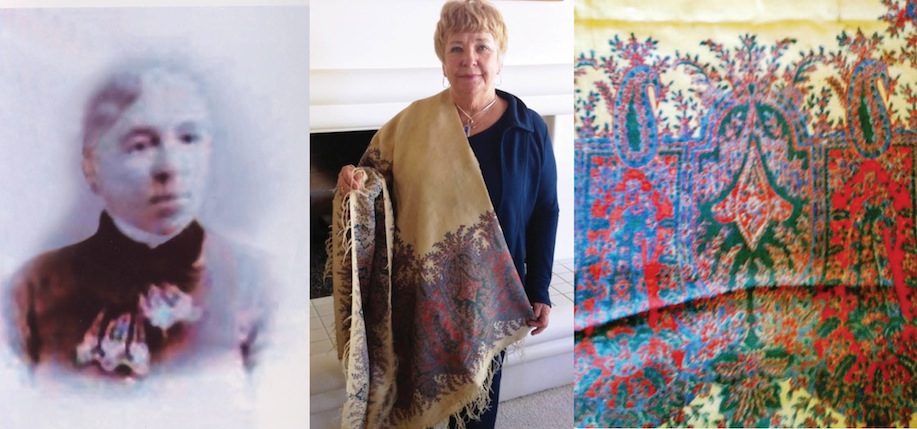Bridget O’Donnell of Cork, Ireland, my great-grandmother, was sent out to Boston by her father in 1846. A recent discovery of her photograph in the Lyons family bible reignites interest in her story and our origins.
Bridget was 14 years old, soon to be 15, when her father took her to Cobh, expecting to book passage for her to America. He gave her for the journey a silver butter knife and a linen-wool shawl made with flax and wool from his small plot of impoverished land outside of Cork City. Mr. O’Donnell had carefully saved enough coins from selling milk to purchase tickets in steerage for Bridget and her 17-year-old sister Catherine, who were traveling with some cousins to America.
They discovered that the ship captain would not take a single young girl. So father O’Donnell and daughter Bridget hung around a few days, searching for a prospective husband until they spotted a gentleman who was booking passage to America. They proposed to him: would he like to get married to a beautiful young Irish girl, about to turn age 15? He said, “Yes.” They went to the church in Cobh, got married and the newlyweds set sail on the next ship to Boston.
They were but one couple of many from nearly destitute Irish families, scarred by British colonial rule and starvation, who were forced to immigrate to America. An Irish immigrant who settled in Wisconsin later would write of the period, “Parents’ aspirations for their children were to send everybody out because there was nothing there and there still isn’t.”
In 1846, immigrants who traveled in steerage were segregated, men and women kept apart. Bridget’s husband took fever on the ship. When they landed in Boston, she could not find him. She was taken in by the DuPont family where she became a nanny-maid. There she learned to read and write. The DuPonts of Massachusetts were very kind to her. She said, “they were well to do but not rich.” Eventually, she found her bridegroom who was very ill. The DuPont family permitted Bridget to take him in to live with them and she nursed him back to health.
In time, Bridget and her husband set out for Illinois. He went to fight in the Mexican War (1848) and was never heard from again. Their two young children died during the “black diphtheria” epidemic.
The young widow Bridget later moved to Wisconsin where she met James Crossgrove, a blacksmith and widower. They married and Katharine, my grandmother, was born in 1865. Twenty years later, Katharine graduated from Beloit Wisconsin Normal School and went to teach in the Irish farming community at Lake Badus, South Dakota where the Lyons side of my family had migrated from Iowa around 1880. A strong, beautiful woman, Katharine married a handsome young Irish farmer, Will Lyons, my grandfather, in 1887.
My cousin Katharine says, “Grandma Kate told me that her mother, Bridget, never regretted leaving — so hungry and poor they were — she had gratitude to have gotten out of Ireland.”
Bridget smoked her cob pipe while saying her rosary beads daily. At age 84, the year of Dublin’s Easter Rising in 1916, Bridget died. Her linen-wool shawl and silver butter knife passed to Katharine, and then to Katharine’s daughter, my aunt Mary, who passed it on to her daughter, Katharine Perko who now lives in Arizona.
Apparently, my grandmother Kate pasted the photo of her mother Bridget in the Lyons family bible. That photo was rediscovered this spring at my brother Pat’s farm in Yankton, South Dakota. The faded photo and the linen shawl provide links for the great-grandchildren of Bridget O’Donnell Crossgrove to honor with great respect this young woman from Cork whose challenging journey made ours possible in America.
Bridget’s story is but one of near-countless others like this and is a testament to the Irish and to the women of Ireland who came to this country and survived. Their spirit, their resourcefulness, and their contributions to building our country as immigrants continue to challenge us and inspire us (some of us!).
– Submitted by Robert F. Lyons
Kennebunkport, Maine


Bob,
I am moved to tears by your account of Bridget’s life. The resilience she displayed is from another era, not our own. We have everything she lacked in terms of food, shelter, stability of place, but how many of us could leave family behind, and how many parents could make the courageous decision of her father? You have made her live again for readers of your article. And who knows what lives may thus be inspired?
Such a powerful story of a young Irish girl leaving home. The courage it took to go along with her father’s plan shows her complete faith in him and the utter desperation of their lives in Ireland. Thank you for sharing this story I was researching Irish grandmothers’ shawls when I came across it. As I now have a grandson I would like him to have the feeling and comfort of being wrapped in grandma’s arms and shawl. I hope I can find more info on how they were made and make one myself. You are lucky to have your Grandmother’s it would be great to know the story of the children who were soothed in her arms with that shawl wrapped around them. Mary Reilly